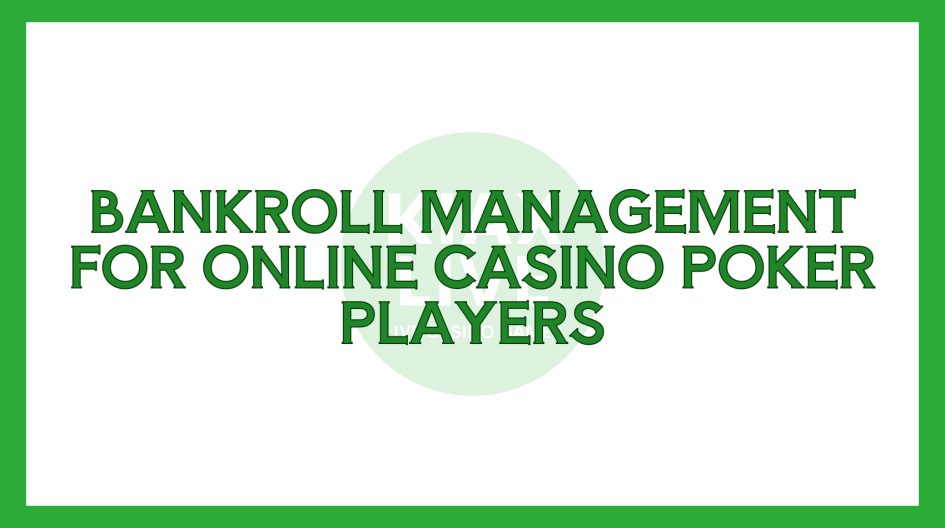Understanding the Importance of Poker Bankroll Management
In poker, skill and strategy often dominate the spotlight — but even the most talented players can lose everything without solid bankroll management. Whether you’re grinding cash games, joining live tournaments, or testing your luck at live dealer poker tables, managing your bankroll is what separates professionals from recreational players.
Unlike slots or roulette, poker involves long-term decision-making, variance, and streaks of both good and bad luck. Without a structured system, even the best poker strategies collapse under financial pressure. Poker Bankroll Management is the foundation that ensures you can play consistently, survive downswings, and maximize profits when fortune favors you.
What Is a Poker Bankroll?
Defining Your Poker Bankroll
In the world of online and live poker, your poker bankroll is more than just the money you use to play — it’s your foundation for long-term success. A bankroll is a dedicated fund set aside solely for poker, separate from your personal finances, daily expenses, or emergency savings. Think of it as your poker “business capital.” Just like an entrepreneur needs capital to operate, a poker player needs a stable bankroll to sustain the ups and downs of the game.
A well-managed poker bankroll ensures that:
- You can keep playing through inevitable losing streaks without emotional pressure.
- You never gamble with money meant for essentials like bills, rent, or savings.
- You maintain financial stability and a clear boundary between leisure and livelihood.
In short, your bankroll acts as a safety buffer against variance, protecting you from short-term swings while allowing your skill and strategy to shine over the long term.
It represents your poker operating budget.
You use it to buy into games, recover from losses, and invest in better opportunities (like higher stakes or tournaments) when your skills and funds allow.
It supports responsible play.
With a proper bankroll, you can approach each game calmly and logically, without the fear of losing money you can’t afford.
It secures your long-term poker journey.
Instead of being at the mercy of luck, your bankroll ensures you can weather short-term downswings while aiming for consistent growth.
Bankroll as a Tool for Discipline
A disciplined bankroll is one of the hallmarks of a successful poker player. Many beginners fall into the trap of mixing personal savings with poker funds — a dangerous habit that leads to poor decision-making and unnecessary stress.
When your bankroll is isolated, it gives you structure and control. You know exactly how much you can risk, and you’re less likely to make impulsive choices after a bad beat or during a hot streak.
A disciplined Poker Bankroll Management plan means:
- You can handle variance calmly. Variance — the natural swings of luck in poker — affects everyone. A proper bankroll cushions the blow.
- You avoid emotional or “tilt” betting. Players often chase losses after tough hands. A structured bankroll limits those emotional responses.
- You stay focused on smart play, not survival. Instead of trying to “win back” what’s lost, you focus on making mathematically sound and strategic decisions.
💡 Pro Tip: Treat your bankroll as an investment portfolio for your poker career. You wouldn’t risk your entire savings on one stock — likewise, don’t risk your entire poker fund on one session. Track every deposit, withdrawal, and result carefully using bankroll tracking apps or spreadsheets. Over time, your discipline will pay off in consistency and confidence.
Why Bankroll Management Matters in Poker
Surviving Variance
Every poker player — from beginners to professionals — faces variance. Even if you make all the correct moves, luck can still cause temporary losses. Without proper bankroll management, those swings can wipe you out before your skills have the chance to shine.
Good bankroll structure ensures:
- You can survive bad beats without panic.
- You’ll always have enough buy-ins to continue playing your preferred stakes.
- You maintain a long-term perspective rather than being discouraged by short-term results.
For example, even elite players with years of experience experience 10 to 20 buy-in downswings during unlucky runs. With smart bankroll planning, these downswings become manageable rather than catastrophic.
Improving Decision-Making
Poker isn’t just about reading cards — it’s about reading yourself. A well-managed bankroll reduces psychological stress, allowing you to think logically and strategically. When you’re not worried about losing your last few dollars, you’re more likely to make rational, math-driven decisions.
Proper bankroll management helps you:
- Fold wisely: It’s easier to let go of marginal hands when your bankroll isn’t at risk.
- Stay consistent: You can stick to your betting patterns without making sudden emotional adjustments.
- Play confidently: With financial stability, you’re free to focus on the quality of your play rather than your chip count.
💡 Example: Imagine two players — one with a $100 bankroll playing $10 tables, and another with a $1,000 bankroll playing the same stakes. A bad beat will tilt the first player, but the second player shrugs it off and keeps playing optimally. The difference? Bankroll management.
Long-Term Profitability
Poker is a game of skill over time, but luck influences short-term outcomes. Proper bankroll management allows you to play enough hands to let skill overtake luck. This long-term edge is what separates consistent winners from impulsive gamblers.
Here’s why it matters:
- You maximize your playtime. The more hands you play, the more opportunities you have to capitalize on your skill edge.
- You build experience safely. Managing your bankroll properly gives you time to learn from mistakes without going broke.
- You compound profits. As your bankroll grows, you can gradually move up in stakes while maintaining safety margins.
💡 Key Insight: With disciplined Poker Bankroll Management, you’re not just protecting your money — you’re protecting your mindset. The best poker players don’t chase wins; they protect their ability to play another day.
Setting Up Your Poker Bankroll
Step 1: Determine Your Total Budget
Decide how much money you can comfortably allocate to poker. For casual players, this could be a small entertainment budget. For serious players, it might be a dedicated monthly fund.
A simple guideline:
| Player Type | Recommended Bankroll | Example |
| Casual | 20–30 buy-ins | $200–$300 for $10 games |
| Intermediate | 50 buy-ins | $500–$1,000 for $20 games |
| Professional | 100+ buy-ins | $2,000+ for $20 games |
Step 2: Divide by Game Type
Different poker formats require different bankroll sizes due to varying levels of variance:
- Cash Games: 20–40 buy-ins.
- Sit & Go Tournaments: 40–60 buy-ins.
- Multi-Table Tournaments (MTTs): 100+ buy-ins (variance is high).
- Live Dealer Poker: 30–50 buy-ins (depends on table limits).
Step 3: Track Your Results
Keep a poker journal or use bankroll tracking apps. Monitoring wins and losses helps you identify leaks and adjust your strategy.
Key metrics to log:
- Date and format of game played.
- Entry fee or buy-in.
- Win/loss result.
- Total bankroll after each session.
Managing Bankroll for Different Poker Formats
Cash Games
Cash games are stable compared to tournaments because you can leave at any time. However, swings still happen.
- Keep at least 30–40 buy-ins for your current stake.
- Drop down in stakes if your bankroll drops below 25 buy-ins.
- Move up only after consistent success for 10+ sessions.
Tournaments
Tournaments offer massive payouts but carry extreme variance. You might play perfectly and still not cash for several games.
- Maintain 100+ buy-ins for your average tournament buy-in.
- Consider using a “stop-loss limit” — e.g., stop for the day after losing 5–10% of your bankroll.
Live Dealer Poker
Live poker adds a social element, making emotional control even more important.
- Budget for longer sessions and potential slow play.
- Keep 30–50 buy-ins available to handle fluctuations.
- Take short breaks to maintain focus.
Key Poker Bankroll Management Strategies
1. Fixed Limit Rule
Set a limit for how much you’ll bring to each session — never exceed it.
Example:
If your bankroll is $1,000, only bring $100 (10%) to a single session.
2. The 5% Rule
Never risk more than 5% of your total bankroll on any single game or tournament.
This prevents a single bad run from wiping out your funds.
3. Stop-Loss and Win Goals
Set clear limits to protect your bankroll and profits:
- Stop-Loss: Quit if you lose a certain amount (e.g., 10% of your bankroll).
- Win Goal: End your session when you reach a profit target (e.g., 20% gain).
4. Adjusting for Skill and Confidence
As your skills improve and results stabilize, you can gradually take more calculated risks. But always stay within the comfort zone of your bankroll.
Common Mistakes in Poker Bankroll Management
Overconfidence After Winning
Winning streaks can lead to reckless betting. Stick to your limits even when you’re ahead.
Chasing Losses
Trying to recover losses by raising stakes is one of the most common mistakes.
This behavior destroys discipline and bankroll stability.
Ignoring Variance
Variance is inevitable. Even professionals lose hands, sessions, or days.
The key is to play enough volume and let skill overcome luck in the long term.
Practical Bankroll Tips for Online Casino Players
Use Separate Accounts
Keep your poker bankroll separate from your personal finances to avoid accidental overspending.
Leverage Bonuses Wisely
Online casinos often offer deposit bonuses and loyalty rewards. Use them to extend your bankroll, but always check wagering terms.
Take Advantage of Low-Stakes Tables
For beginners, low-stakes poker offers the perfect environment to practice bankroll management and sharpen skills without large financial risk.
Track Performance and Emotions
Keeping notes on how you felt during losses or wins helps you identify emotional triggers that could lead to bad bankroll decisions.
Bankroll Management Table for Quick Reference
| Game Type | Recommended Buy-ins | Variance Level | Example Bankroll |
| Cash Games | 30–40 | Medium | $600–$800 |
| Sit & Go | 40–60 | Medium–High | $800–$1,200 |
| Tournaments (MTTs) | 100+ | High | $2,000+ |
| Live Poker | 30–50 | Medium | $600–$1,000 |
Staying Disciplined and Playing Smart
Bankroll management is more than numbers — it’s a mindset.
It’s about knowing when to play, when to stop, and when to step back. By controlling your money, you control your emotions, which directly improves your performance at the table.
💡 Pro Tip: Many professional players say they don’t play poker for money — they play for the right decisions. The money simply follows.
Conclusion: Mastering Bankroll Discipline with Kiax Live

Where Real Dealers Meet Real Wins
Poker success isn’t about avoiding losses — it’s about surviving them. A well-managed bankroll gives you the confidence to make strategic plays without fear of ruin. Whether you’re grinding micro-stakes online or playing live dealer poker, the principles of Poker Bankroll Management remain the same: play smart, stay patient, and protect your funds.
For more guides like this, explore the Live Poker category on Kiax Live — your trusted resource for mastering Live Baccarat, Blackjack, Poker, and Roulette strategies across Southeast Asia.

Leave a Reply